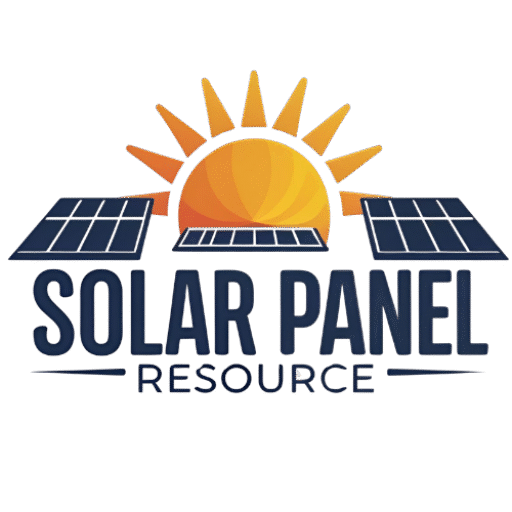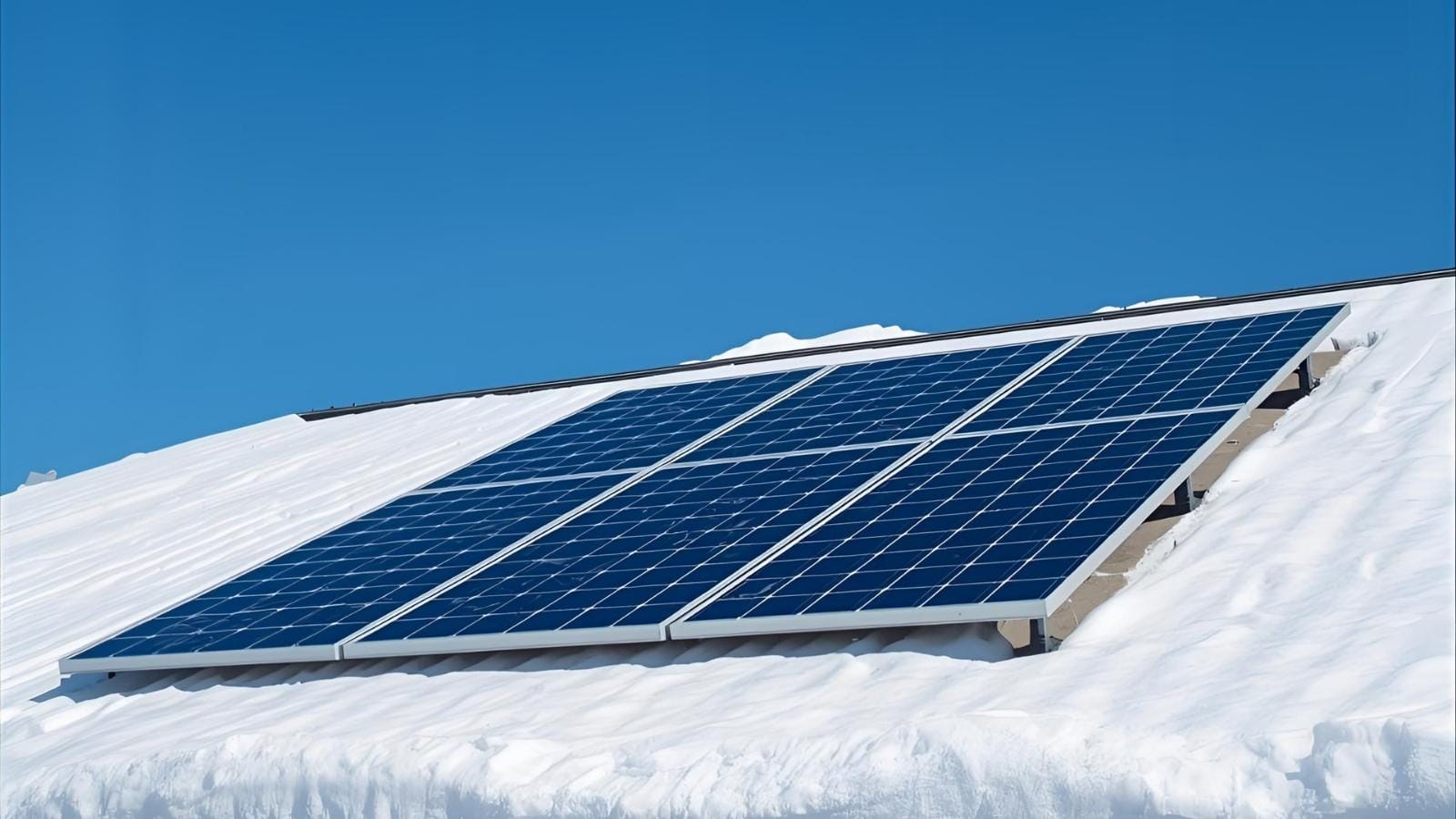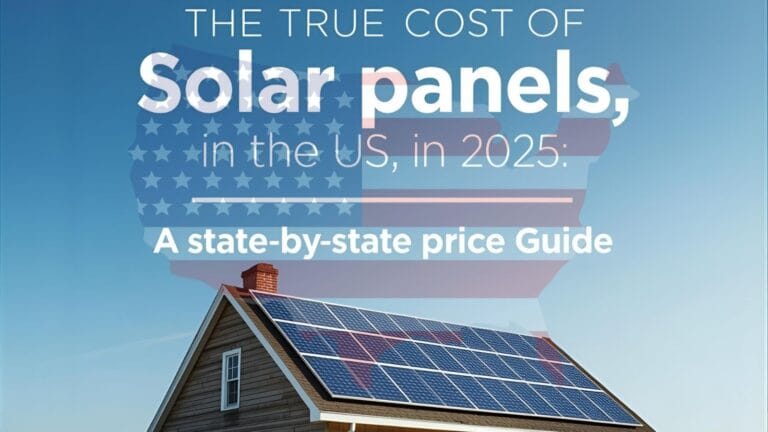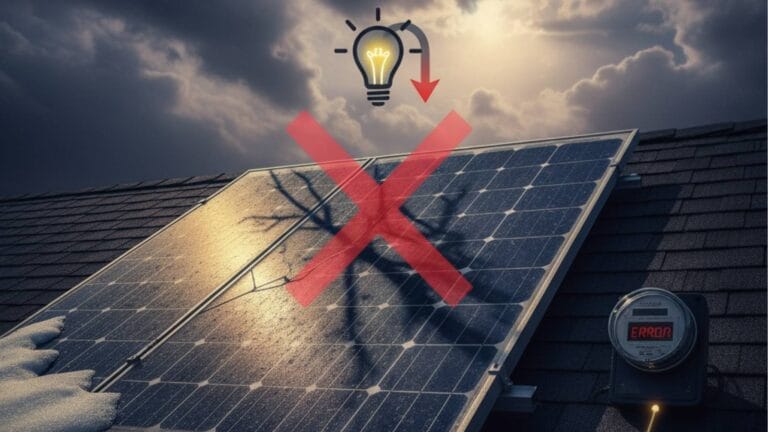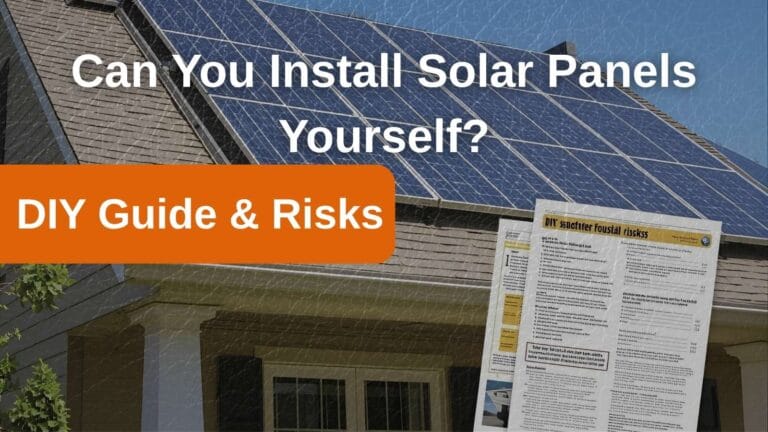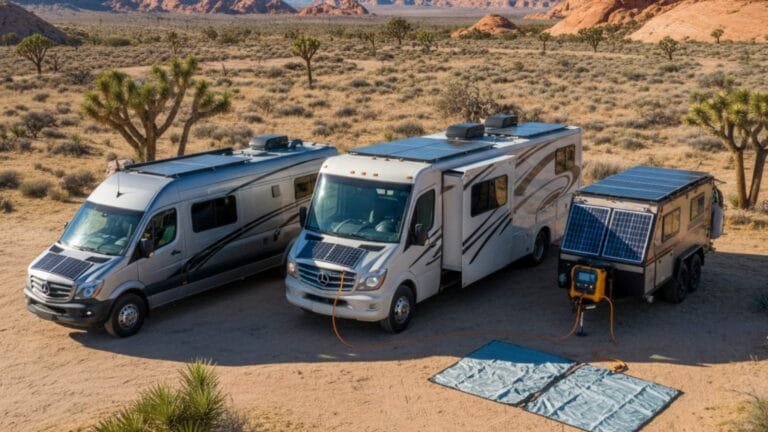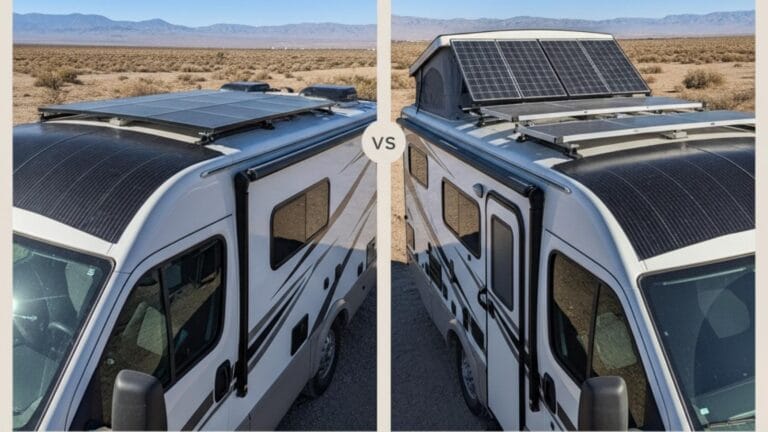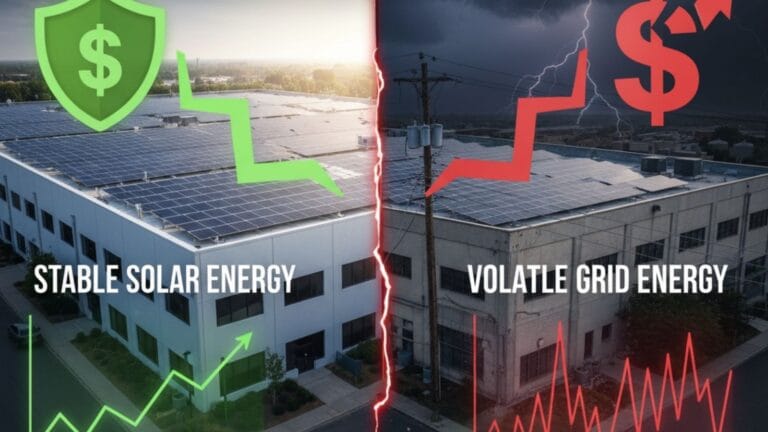The Best Solar Panels for Cold Climates and Snowy Regions in 2025
As an Amazon Associate, I earn from qualifying purchases. This post contains affiliate links to products we recommend.
A common misconception persists that solar panels are only effective in hot, desert-like climates. We explore this fully in our guide on how solar panels work in snow, rain, and extreme heat. The reality is counter-intuitive: solar photovoltaic (PV) panels are electronic devices, and like most electronics, they function more efficiently in cold, clear weather than in extreme heat. Heat introduces resistance, which lowers power output. Cold, in contrast, improves electrical conductivity, allowing panels to produce more power for the same amount of sunlight.
However, cold climates, particularly those with heavy snowfall, present a unique set of challenges. These include physical stress from the weight of snow and ice, reduced sunlight hours (lower insolation), and the obvious problem of light-blocking snow accumulation. Therefore, choosing the “best” solar panel for these regions is not about peak wattage alone, but about a specific combination of durability, low-temperature performance, and design features that mitigate winter’s impact.
This article provides a comprehensive technical guide for evaluating solar panels and system components for installation in regions prone to harsh winters and significant snowfall in 2025.
Understanding Solar Panel Performance in Winter
Solar panel output is primarily determined by two factors: solar irradiance (the amount of sunlight hitting the panel) and the panel’s own temperature. Winter brings challenges and a key advantage.
- The Advantage: Efficiency Boost. A panel’s power rating is determined at Standard Test Conditions (STC), which assume a cell temperature of 25°C (77°F). For every degree the panel operates *below* this, its voltage increases, boosting power output. A clear, freezing-cold winter day can result in panels producing *more* than their rated power.
- The Challenges: Insolation and Obstruction. The primary drawbacks of winter are shorter days and a lower sun angle, which reduces total “sun hours.” The most significant challenge is physical obstruction from snow, which can halt production entirely until it is cleared.
Successfully navigating these factors requires prioritizing specific technologies. In fact, many of the world’s most successful solar adopters are in cold regions. The IEA Photovoltaic Power Systems Programme notes that countries like Germany, Canada, and Scandinavia have mature solar markets, proving that low temperatures are not a barrier to effective generation.
Key Features to Demand for Snowy Conditions
When comparing solar panel data sheets for a cold-climate installation, four specifications are non-negotiable. These metrics separate a standard panel from one truly engineered for winter resilience.
What is the Temperature Coefficient and why does it matter?
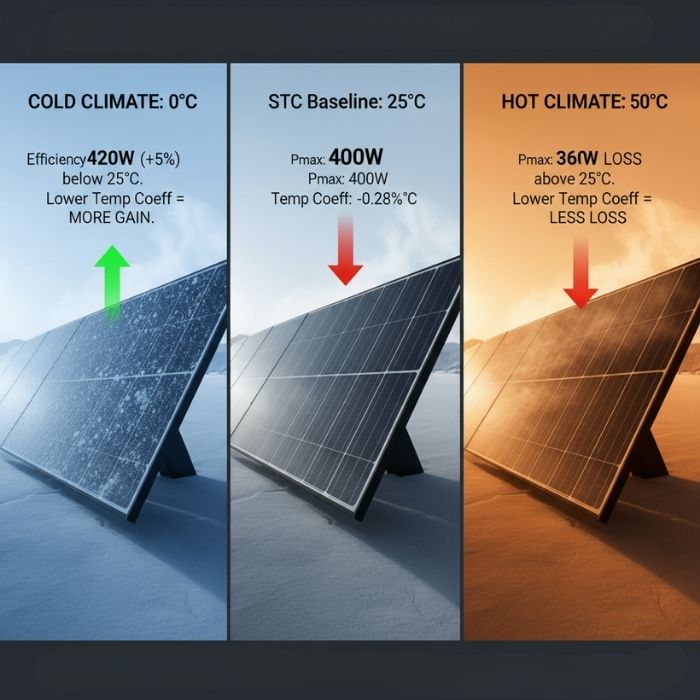
The temperature coefficient of Pmax (maximum power) measures how much power a solar panel loses for every degree Celsius its surface temperature rises above the 25°C STC baseline. This figure is expressed as a negative percentage (e.g., -0.35%/°C).
In a cold climate, this metric is doubly important. While all panels lose power in the heat, a lower (closer to zero) temperature coefficient is superior. A panel with a -0.28%/°C rating will lose less power on a hot summer day than a panel at -0.40%/°C. Critically, this effect reverses in the cold. When the panel’s temperature drops *below* 25°C, it *gains* efficiency. A panel with a better (lower) coefficient gains more power in the cold, making it a more stable and efficient producer year-round.
For 2025, premium monocrystalline N-type panels, such as TOPCon (Tunnel Oxide Passivated Contact) models, boast some of the best temperature coefficients, often between -0.25%/°C and -0.32%/°C.
How important is a high snow load rating?
A high snow load rating is critically important for structural integrity in regions with heavy snowfall, preventing the panel frame from bending or the glass from cracking under heavy, wet snow.
This rating is measured in Pascals (Pa), a unit of pressure. Look for two load ratings:
- Dynamic/Wind Load: Resistance to pressure from wind (typically ~2400 Pa).
- Static/Snow Load: Resistance to a fixed, downward pressure, like accumulated snow (typically 5400 Pa or higher).
A 5400 Pa rating is considered the standard for robust panels, equivalent to withstanding approximately 112 pounds per square foot (5.4 kilonewtons per square meter). For extreme alpine or high-latitude regions, installers may source panels with ratings of 6000 Pa or even 8000 Pa. Never install a panel with a low load rating in a snowy area, as it risks catastrophic failure.
EDITOR’S PICK: Recommended Panel for Harsh Conditions (DIY Choice)
While premium brands list 5400+ Pa panels, they require installer quotes. For the best DIY durability available on Amazon that meets high standards for structural integrity, we recommend the Renogy 200 Watt Monocrystalline Panel. It is a proven, reliable choice for cabins and cold-weather applications. [Check Price and Snow Load Ratings on Amazon]
Are bifacial solar panels worth it in snowy areas?
Yes, bifacial solar panels are often worth the extra cost in snowy areas because they can generate additional power (a ‘bifacial gain’) by capturing sunlight reflected off the snow onto their rear side.
Bifacial modules have solar cells exposed on both the front and back. Their primary advantage in winter is the “albedo effect,” or surface reflectivity. Fresh snow has a very high albedo, reflecting 80% to 90% of the sunlight that hits it. A bifacial panel mounted above a snow-covered surface can absorb this reflected light, dramatically boosting winter production.
This ‘albedo effect’ is well-documented; research from bodies like the U.S. National Renewable Energy Laboratory (NREL) has shown significant performance gains from bifacial modules in snowy environments. This gain is most effective on ground-mount systems or roof mounts with a high tilt angle and several feet of clearance, allowing light to reach the rear of the panel.
Do panels with “dark” or all-black aesthetics help melt snow?
Yes, darker panels (like all-black monocrystalline modules) absorb more heat, which can help them warm up faster and shed snow slightly more quickly than panels with white backsheets, but this effect is minimal.
While a helpful minor benefit, this should not be a primary decision factor. A more significant design feature is a frameless or “glass-on-glass” design. Traditional panels have a raised aluminum frame, which can create a “lip” at the bottom edge, catching snow and ice and preventing it from sliding off. Frameless modules allow snow to slide off unobstructed, improving “shedding” performance.
Panel Technologies: Monocrystalline vs. Polycrystalline vs. Thin-Film in Cold
In 2025, the market is dominated by monocrystalline technology. However, it’s useful to compare the three main types for their cold-weather attributes. We can evaluate them based on the criteria established above.
| Feature | Monocrystalline (Mono-PERC, TOPCon, HJT) | Polycrystalline (Multi) | Thin-Film (CdTe, CIGS) |
|---|---|---|---|
| Efficiency | Highest (20% – 24%+). Produces the most power in a limited space, which is crucial for low-sun winter days. | Moderate (16% – 19%). Largely phased out for new residential/commercial installations in 2025. | Varies (10% – 19%). Efficiency has improved but generally trails monocrystalline. |
| Temp. Coefficient | Excellent (Lower). N-type (TOPCon, HJT) panels lead the market with Pmax coefficients often -0.25% to -0.32%/°C. | Good. Typically slightly worse (more negative) than monocrystalline, around -0.38% to -0.42%/°C. | Best. This is thin-film’s greatest strength. It is least affected by temperature changes, with coefficients as low as -0.20%/°C. |
| Low-Light Performance | Very Good to Excellent. Modern PERC and HJT technologies have excellent diffuse light capture for overcast days. | Good. Performs adequately but is generally outperformed by modern mono panels. | Excellent. Thin-film technology is known for its superior performance in low-light and cloudy conditions. |
| Cold Climate Verdict | Excellent Choice. The clear winner for most applications. Its high efficiency is the most important factor for maximizing energy from weak winter sun. Its superior temperature coefficient provides a stable, powerful output. | Not Recommended. While functional, its lower efficiency and outdated technology make it a poor investment in 2025. More roof space is required for the same power. | Good Niche Choice. If space is unlimited and low-light/cloud cover is more of a problem than snow, thin-film is a viable option. However, its lower power density is a significant drawback for most roof installs. |
For nearly all residential and commercial installations in cold climates, N-type Monocrystalline (e.g., TOPCon or HJT) panels are the superior choice. They combine the highest efficiency, excellent temperature coefficients, and high snow load ratings (when built with robust frames).
While we compare these technologies for cold weather, you can explore a complete breakdown in our Monocrystalline vs Polycrystalline vs Thin-Film guide.
System Design Considerations Beyond the Panels
The “best” panels can be rendered ineffective by poor system design. In snowy regions, the supporting components (inverters and racking) are just as important as the panels themselves.
How do microinverters improve winter performance?
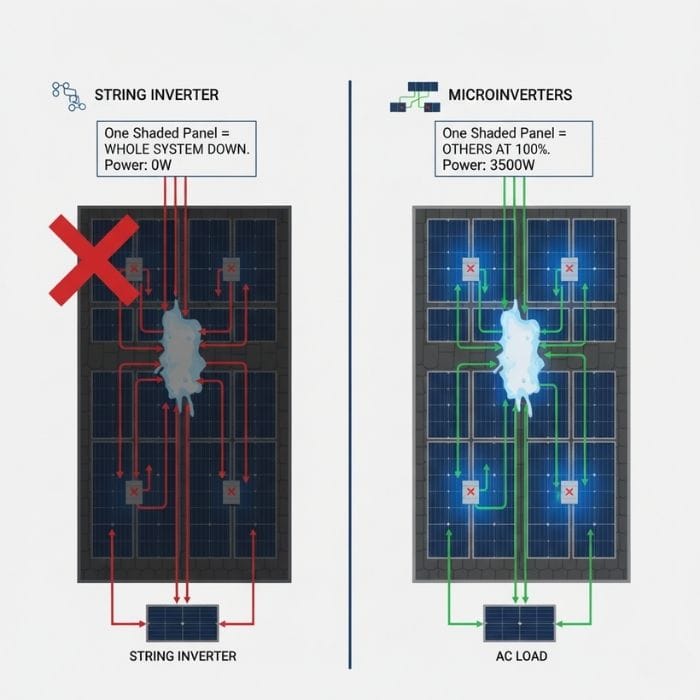
Microinverters improve winter performance by isolating the output of each panel, preventing a single snow-covered or shaded panel from reducing the output of the entire system.
Solar panels in a “string” (wired together to a single string inverter) are like a set of old holiday lights—if one goes out, the whole string fails. If one panel in a string is covered by a patch of snow, its production drops to zero, and the output of all other panels in that string is dragged down to match it.
Microinverters (or DC Power Optimizers) are small devices that are installed, one per panel. They convert the DC power to AC at the panel level. This makes each panel an independent power producer. If one panel is covered in snow, it simply stops producing, while all other panels continue to operate at 100% capacity. This is an essential feature for any climate with partial, patchy snow cover.
Learn more about the pros and cons in our Microinverter vs. String Inverter comparison.
What is the optimal solar panel tilt angle for winter?
The optimal tilt angle for winter is steeper than for summer, typically “your latitude plus 15 degrees,” to help panels shed snow and catch the low-angled winter sun.
The sun is much lower in the sky during winter. A steeper tilt angle (e.g., 40-50 degrees) faces the sun more directly and has the significant co-benefit of helping snow slide off naturally using gravity.
- Rooftop Systems: You are often limited by the pitch of your roof. Installers will use the steepest available angle.
- Ground-Mount Systems: This is where optimization is possible. A ground-mount array can be set at the ideal steep winter angle. Some systems even offer adjustable tilt, allowing you to change the angle seasonally for maximum production (though this adds cost and labor).
What maintenance is required for solar panels in winter?
Minimal maintenance is required, as panels are designed to be durable. The main task is snow removal, which should only be done if it is safe to do so and if accumulation is heavy and persistent. For year-round care, see our full guide on how to clean and maintain solar panels.
Safety is the absolute priority. Never get on an icy roof to clear panels. If panels are safely accessible from the ground, a long-handled, soft-bristled “roof rake” designed for solar panels can be used. Never use hard or sharp tools, as you can scratch the glass. Do not use hot water, as the thermal shock can crack the glass.
In many cases, the best approach is patience. A small amount of sunlight will often warm the dark panels enough for the snow to melt and slide off on its own, especially on a steeper tilt.
Essential Winter Gear: Don’t let snow block your power generation. We recommend keeping a Snow Peeler & Roof Rake handy to safely clear your panels from the ground without scratching them. [Check Price on Amazon]
Geographic Incentives and Regional Considerations
The financial viability of a solar project in a cold climate depends heavily on local regulations and incentives. These factors reduce the high upfront cost of a winter-resilient system.
What subsidies are available for cold-climate solar installations?
Subsidies vary significantly by country and region, but often include tax credits, feed-in tariffs, or rebates designed to lower the initial installation cost. These incentives are critical and should be researched with a local installer.
Always clarify with your installer that prices and incentives are estimates and vary significantly based on your exact location, available subsidies, and local labor costs.
- In the United States: The primary federal incentive is the Investment Tax Credit (ITC), which (as of 2025) allows a 30% deduction of the total system cost from federal taxes. You can find a complete walkthrough in our guide to claiming the 30% solar tax credit. Many cold-weather states, like Minnesota, New York, and Massachusetts, have additional state-level rebates or performance-based incentives (like SRECs).
- In the European Union: Policies are set by member states. Germany, a cold-climate solar leader, has a mature market built on its Renewable Energy Sources Act (EEG), which provides a “feed-in tariff” (Vergütungssätze) that guarantees a fixed payment for generated electricity, though this is shifting more to auction-based systems.
- In Emerging Markets (e.g., Türkiye): Countries with high solar potential and cold interior regions, like Türkiye, are actively promoting rooftop solar. Programs include feed-in tariffs under the YEKDEM mechanism and net-metering regulations that credit owners for surplus energy, making solar viable even in snowy, high-altitude provinces.
Before any purchase, consult local building codes and energy regulators to confirm which incentives apply to your project.
Complete Starter Kits for Cold-Weather Preparedness
If selecting individual components seems overwhelming, a complete starter kit is the safest path. For cold climates and regions with lower light levels, we specifically recommend kits that include MPPT charge controllers. Unlike standard PWM controllers, MPPT technology extracts significantly more energy during cloudy winter days, keeping your battery bank charged when you need it most.
Our Top Recommendation: [Renogy 400W Solar Starter Kit with 40A MPPT Controller]
This comprehensive kit includes:
- Rigid Monocrystalline Panels: Built to withstand heavy snow loads (5400 Pa).
- Rover MPPT Controller: Maximizes efficiency in low temperatures.
- Mounting Z-Brackets: Secure installation hardware included.
Making Your Decision
Choosing the best solar panels for a cold climate in 2025 is an exercise in prioritizing resilience and specific performance metrics over simple peak wattage. A system that thrives in winter is a combination of durable hardware and smart, climate-aware design.
When evaluating your options, focus on these key takeaways:
- Prioritize a Low Temperature Coefficient: Look for N-type monocrystalline panels with a Pmax coefficient of -0.32%/°C or better (closer to zero).
- Demand a High Snow Load Rating: Do not compromise. A 5400 Pa static load rating is the minimum standard for snowy regions.
- Choose Module-Level Power Electronics (MLPEs): Microinverters or DC optimizers are essential to prevent partial snow cover from disabling your entire array.
- Consider Bifacial Panels: If you have a ground-mount system or a highly-tilted roof with good clearance, bifacial modules can provide a significant boost in winter production by capturing reflected light from snow.
- Optimize Tilt Angle: A steeper tilt angle is always better in winter, both for capturing the low sun and for shedding snow.
Ultimately, the most critical step is to consult with a certified, reputable installer who has specific, verifiable experience designing and building solar arrays in your local climate. They can provide an accurate assessment of your property’s potential and engineer a system built to withstand winter for decades to come.

Solar Energy Enthusiast & Renewable Energy Researcher
Vural’s journey into solar energy began four years ago, driven by frequent power outages and high electricity bills at his own home. He has since gained hands-on experience with both personal and commercial solar projects. At solarpanelresource.com, Vural shares his real-world insights and in-depth research to guide homeowners and business owners on their own path to energy independence.
